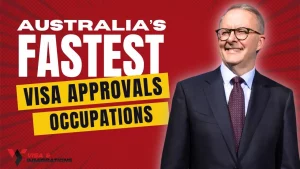There have been many assumptions regarding the outcome of the Jobs and Skills summit. The aim of the Treasury Department led assembly of employers, unions, civil society, and government was to gain insights on solutions, to boost the workforce of Australia with mutual advantages for all stakeholders, and eventually the economy of Australia.
With unemployment at all-time high levels and inflation at alarming rates, there are immediate challenges that may obstruct long-term planning.
Recently, the top 10 highly popular occupations were disclosed based on job vacancies and predicted industry growth in employment through the next five years.
Meanwhile, some of the most highly sought occupations such as construction managers, nurses, and IT positions are on the Medium and Long-term strategic skills Lists, two of the occupations are nowhere to be found:
aged and disability carers and child cares excluding group leaders available to be nominated for a subclass 494 – Skilled Employer Sponsored Regional (Provisional) visa. The summit will possibly address the alarming shortages of workers belonging to these occupations. This may entail adding them to the appropriate occupation lists as well as to the already announced extension of the Pacific Australia Labour Mobility Scheme to include care workers.
Although immigration is a disputed factor, it may deliver short and medium-term solutions to the need for workers, given that the Department of Home Affairs can conduct the application process swiftly.
Inflation in the number of permanent migration numbers could have a minor immediate effect. Unless the overseas applicants are focused upon and in industries and professions, the visa bearer is expected to work in.
The reason for this is that a large number of permanent skilled visa applicants are already present in Australia, most likely bearing a temporary visa with work rights and hopefully employed in the occupation they have nominated (for independent skilled visas) or have been nominated in (for employer sponsored visas).
What is also suggested is a rise in the Temporary Skilled Migration Income Threshold (TSMIT).
The TSMIT is a significant salary floor that is applicable to all the sponsored workers apart from the independent contractor occupations, which are general managers and medical practitioners.
The sponsored employee must have their guaranteed yearly earnings, with the exception of compulsory superannuation and unforeseen grants such as commissions, bonuses, and overtime, to be at least the TSMIT.
The TSMIT is applicable to nominations for the following:
- Subclass 482 – Temporary Skill Shortage visa,
- Subclass 494 – Skilled Employer Sponsored Regional (Provisional) visa,
- Subclass 186 – Employer Nomination Scheme visa, and
- Subclass 187 – Regional Sponsored Migration Scheme visa.
- It is currently $53,900 and has not been reduced since 2013.
The article confirms that employer associations would be satisfied with the least being $60,000, a think tank proposes $70,000 and the Australian Council of Trade Unions proposes a raise to $91,000 and attached to Australian average earnings.
What many individuals, including Australian senators, do not comprehend is that while the TSMIT is a floor, without any calculation methodology, it cannot be fixed to a salary of a migrant worker. The reason being, presence of the Annual Market Salary Rate (AMSR) as well.
The AMSR is the condition for all-employer-sponsored visas mentioned earlier that a nominee’s earnings must be a minimum of what the employer does or would pay, a similar Australian worker (Australian citizen or permanent resident) employee.
Where the similar Australian worker’s terms and conditions are specified by an industrial instrument (such as an award) or enterprise bargaining agreement, the award or agreement will, in result, be the salary floor depending on the instrument. In the absence of the applicability of a wage instrument to the occupation and no coequal worker, data such as job advertisements and remuneration surveys are used as a standard for a nominated salary.
Beside the salary caveat, it is therefore unattainable to sponsor a CEO on a salary of $53,900 per year as there would be no authentic data to justify this. The AMSR is occupation-specific and developed to ward off worker exploitation.
The main problem raising the TSMIT beyond limits is that the AMSR must also be above the TSMIT according to the regulations for the approval of nomination applications.
Occupations that are governed by awards may make it extremely difficult, if not impossible, to sponsor highly skilled workers. For example, the minimum salary of a senior occupational health clinic nurse according to the Nurse Award 2020 is $1328.50 a week, therefore $69,082 per year. Without guaranteed overtime, or with a similar worker on this salary, a $70,000 TSMIT would indicate the refusal of this nomination.
If aged care workers or child care workers were to be included to the list of sponsarable occupations, it would be technically impossible to sponsor them without a notable raise in salaries for both the equivalent worker and sponsored worker.
In the absence of no equal Australian worker and without data to support such a wage, there is no probability of approval. Some trade occupations, like chefs and motor mechanics, would be doubtful to be sponsored under any conditions. And even if the AMSR was customized to permit foreign nationals to be paid at least the TSMIT while the AMSR was below the TSMIT, it may have resulted in Australian workers feeling distraught about their higher-paying colleagues.
Therefore, an increment to the TSMIT to $91,000 may be restrictive to many occupations that are in demand.
This is the end of today’s blog update. We hope you found this blog useful. Please don’t forget to support us by subscribing to our newsletter and sharing this blog with your friends and family on Facebook, Whatsapp, and Twitter.
Recent Posts:
- Skilled & Business Migration Programs 2022-23 Are Now Open
- Australia Announces Migration Program Planning Levels For 2022-2023
- Australia To Prioritize PR Applications To Fight The Backlog
- Pr Opportunites For Temporary Skill Shortage Visa Holders
- New Changes To The Australian Migration Programme












